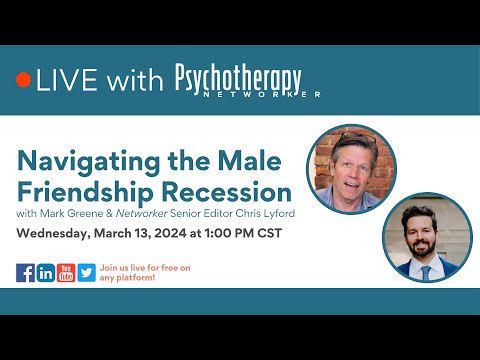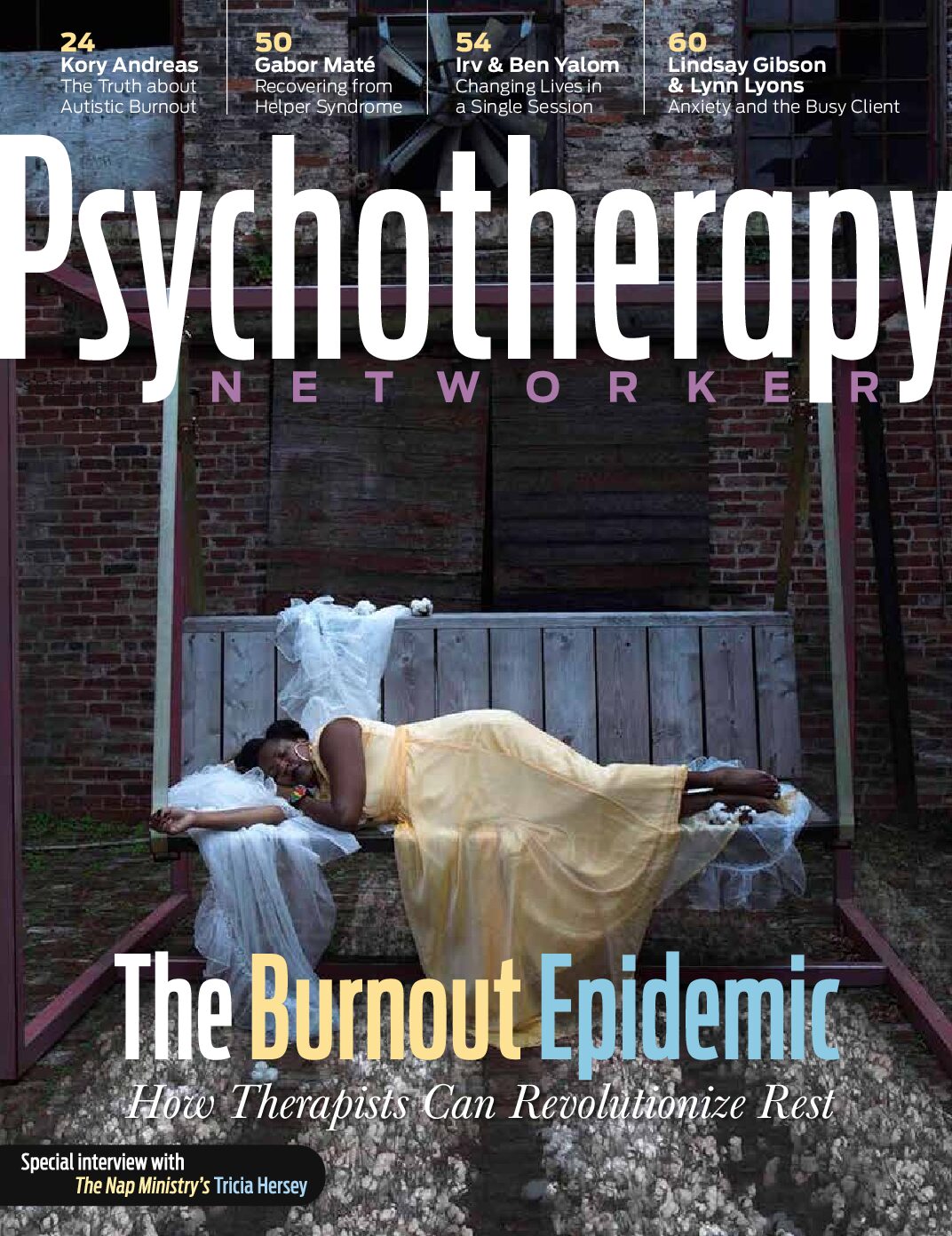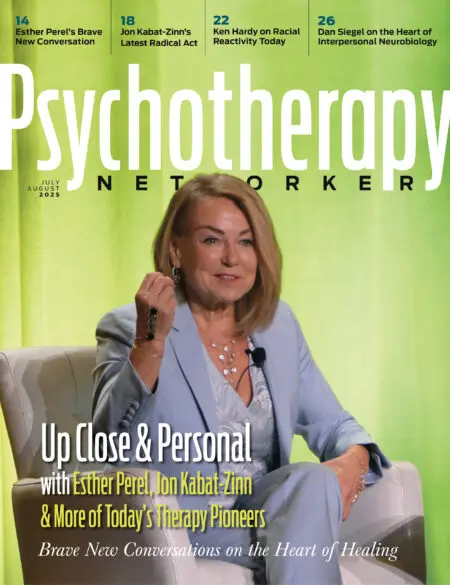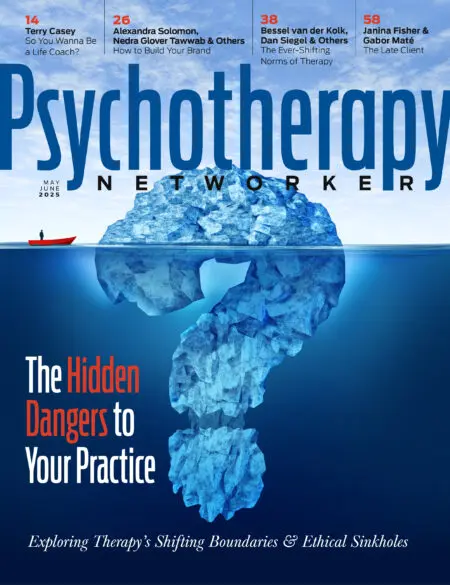It’s been 40-odd years since the therapy field got its first feminist corrective. The most influential figures in that initial challenge to the status quo were the four members of the Women’s Project in Family Therapy—the brainchild of the outspoken family therapists and trainers Marianne Walters, Betty Carter, Peggy Pap, and Olga Silverstein—who, with a lively spirit and a visceral conviction, took aim at the sexist underpinnings of many of the male-authored theories and practices that they insisted reinforced patriarchal gender roles.
Until then, therapists, the majority of whom were women, had been trained in approaches that rarely questioned men’s roles as emotionally self-sufficient providers and protectors, and women as the nurturers who were responsible for the intimate raising of children and loving support of men. Of course, since in this arrangement the women’s primary job was supposed to be taking care of the husband’s and children’s emotional needs, she bore a larger share of the blame for any slip-ups or family dysfunction. It was often she whom clinicians asked to do the changing in therapy, while the role of fathers was minimized or ignored. Nothing drew the ire of the Women’s Project more than the implicit message of mother blaming in many therapeutic approaches.
As was probably inevitable in any attempt to shake up an entrenched cultural institution like the psychotherapy field, the members of the Women’s Project were sometimes seen as confrontive and polarizing. Many men in the field felt that they were now being cast as countertherapeutic reactionaries. Nevertheless, the Women’s Project held fast to opposing the supposition that the family could ever be considered in a vacuum, and insisted that therapists needed to go beyond the narrowness of their training and incorporate an understanding of the broader cultural context shaping their clients’ lives. In particular, they needed to move beyond the idea that gender roles were somehow fixed and inevitable, while arguing that family structure was far more flexible than the field’s originators had accounted for.
It’s a measure of the pervasive impact of feminist thinking, within both the therapy field and the wider culture over the past several decades, that for many clinicians, the critique has begun to feel less pressing, as if the battle has finally been won. Other social shifts, like the acceptance of gay marriage, the rise of LGBTQ families, and young people coming out as transgender or gender nonconforming have moved into the forefront of the field’s awareness.
Today’s families look very different from what they were back then. Both partners working has become the norm—70 percent of mothers with children under 18 are in the labor force, with 75 percent of those working full time. The number of stay-at-home dads has risen to double what it was 20 years ago. And the amount of time fathers spend on childcare and household chores has tripled and doubled, respectively, since the late ’60s (although it’s still just a little more than half of what mothers put in each week). According to Pew research, 7 in 10 adults think it’s equally important for new babies to bond with both mother and father, and more than half believe it doesn’t matter which parent stays home with a young child. And now, in a note that would’ve stunned the field 40 years ago, just as many fathers as mothers say parenting is “extremely important” to their identity.
But just when it seemed like these new expansions of roles and definitions of family reflected a broad-based shift in the culture, a president won office with what many in and out of the field saw as the hypermasculine embodiment of everything that was wrong with patriarchy. In the wake, male feminist therapist Terry Real warned readers of the Networker of the resurgence of patriarchal attitudes that were deeply damaging to intimate relationships, urging therapists to abandon neutrality in their work whenever they encountered “male aggression, narcissism, sexual assaultiveness, grandiosity, and contempt.” Then, in a kind of dam break, came the fracturing reality of today’s #MeToo movement, offering men and women a disturbing look at how rampant sexual harassment and assault continue to be, in and out of the home.
Since then, the view that both masculinity and femininity are ultimately social constructs containing many mixed messages and contradictions has become part of everyday therapeutic discourse. And a key element in this reexamination of gender identity as a therapeutic issue is the idea that while men may not express their vulnerability and desire for intimacy in the same way as women, they nevertheless possess an emotional depth that they’ve been raised not to plumb.
Recently, Esther Perel organized a conference she called “The Masculinity Paradox,” which attempted to clarify what might be the next step for the field in grappling with the internalized gender codes that shape identity and exert such a powerful influence on intimate relationships. The meeting emphasized the importance of creating an atmosphere of acceptance and curiosity in therapy, offering both men and women an expansive space to fully express themselves as they journey through this still largely uncharted territory. Here, Perel offers her perspective on how therapy has evolved in its exploration of the role of gender identity and where we need to go from here.
Esther Perel on the Lives of Men
Psychotherapy Networker: In the 70s, 80s, and early 90s, the watchword for the intellectually adventurous in this field used to be context. Whether it was about gender, race, or class, a lot of conversation centered around how the larger dimensions of identity and culture were relevant to therapy. But that focus on context has seemed to fade over the years. What happened?
Esther Perel: It’s all part of a pendulum swing. Years ago, Salvador Minuchin, the father of structural family therapy, taught us about the importance of context in his work with delinquent boys at the Wiltwyck School. He found that the boys who’d changed their behavior at school soon regressed after being sent home and returned to the context of their family and neighborhood. He showed how we needed to understand that behavior wasn’t something intrinsic within the child, but something dictated by the context in which they lived. So we began to look less at what caused the problem and more at what maintains it. In other words, we looked at how the system was organized.
But as exciting as the family therapy movement was, it underrepresented the psychology of the individual. So the next generation of therapists came along and said, “We need to reinstate the individual,” and that was an important corrective that was simultaneously reinforced by the hyperfocus on individualism in society as a whole. The pendulum swung strongly in the other direction. As a result, our field, like the rest of society, was inducted into the point of view of the individual, too.
PN: Do you think that’s changing now?
Perel: I think it’s time for us to find a way to unite context with individualism. There have been many recent changes in the social and political landscape that we can’t ignore. We realize that we’re not shielded from the rise of authoritarianism. The 2016 election showed those of us who live in liberal enclaves, which includes the majority of therapists, that our social institutions no longer seem so solid, and that we inhabit a restless and anxious world, where our problems can’t be separated from the social and economic crucible in which they occur. Although we promote curiosity, flexibility, uncertainty, and complexity—and aim to introduce that in the lives of our clients—it’s not evident in ours.
Even the #MeToo movement risks perpetuating an understanding of sexual misconduct from an individualistic point of view: justice is not achieved by punishing a few bad apples while we, as a society, ignore the institutions that sustain a culture of harassment.
The focus on individuals like Harvey Weinstein and other predatory men just creates a colony of lepers whom we can blame for the problem. Now, more than ever, we need a multidisciplinary approach that looks at the root cause—where the context meets the individual. We need to bridge the gap, and we need to ensure that our work engages with the current social woes as much as we engage with the individual.
PN: You recently hosted a conference called “The Masculinity Paradox.” What’s the paradox you’re referring to?
Perel: While we focus extensively on the power of men and the privilege of men, we pay much less attention to the fragility of male identity as a constant pursuit and a defense. We’ve never had more of a need to define what makes a man—and we’ve never had less of a means to do so. Our culture of male privilege so deeply informs how manhood is performed that questioning it can feel like a terrifying loss of core identity to some men. That’s why it’s important to recognize that the driving force here is not misogyny, but the fear of losing something that’s fragile.
Rethinking masculinity today doesn’t come out of nowhere. It’s happening because the dominant model has revealed its limitations. In our current world, where the boundaries and distinctions have become more diffuse, it’s become hard to know what it means to be a man, and even harder to feel good about being one. If the 20th century is the century where women made major changes, the 21st century will be the one where the men adapt to the changes women have made. Women have had 50 years to question the narratives of their identities both at home and at work. But ultimately the lives of women will not change until the lives of men come along.
PN: As old conceptions of masculinity have come into question, what’s happened to the distinctions we make about masculinity and femininity?
Perel: Not long ago, women were still considered the mysterious dark continent of humanity. No one dreamt of questioning the meaning of masculinity, which appeared to be self-evident: luminous, natural, and the opposite of femininity. But the language we used to talk about masculinity as a goal and a duty betrayed our cultural certainty. With our boys and adolescents, we talk about masculinity as a mandate, an imperative—“Be a man! Man up!”—not as an indicative. Perhaps this is why we find rituals in every society where boys need to go out and prove their manliness. While girls begin their passage into womanhood by having their periods, boys have societal rituals filled with trials and tasks that need to be accomplished for them to be considered men.
Doesn’t the need to constantly encourage and exhort men to demonstrate their manliness suggest that masculinity isn’t as natural as many would like to think? French philosopher Elisabeth Badinter writes that being a man requires an effort that doesn’t translate to the lives of women. We rarely hear “Be a woman!” We behave as if the feminine is natural and unavoidable, while masculinity has to be acquired, often at a high price. Masculinity is hard to develop, easy to lose.
PN: How do you make the bridge between the understanding of large cultural and social forces like patriarchy and your practice as a therapist?
Perel: A question that I ask all the men I work with, be it in groups or individually or in relationships, is “What part of your identity have you chosen and what has been given to you?” I try to show couples how the patriarchal social system intimately affects both men and women, how they both carry a code that defines manliness as fearlessness, stoicism, and self-sufficiency. Women internalize and perpetuate this code no less than men, although it’s not often acknowledged.
Mothers play a large role in teaching their sons the code and encouraging them to hide their early capacity for being emotionally perceptive, vulnerable, and responsive. They tend to overestimate the physical process of very young boys, down to the kick of a male fetus. They’re the ones giving boys the bigger piece of meat. Research by Carol Gilligan shows that by the age of four, mothers touch their sons less than they touch their daughters. And of course, starting in preschool, boys learn to align their behaviors with the male stereotype our culture projects onto them.
As therapists, we rely on the verbal cure, but when it comes to loving relationships, “talk intimacy” inevitably leaves many men at a loss. As a result, many therapists view men as suffering from a chronic intimacy deficiency that needs ongoing repair. Some have even accused therapists of further perpetuating the “feminization of intimacy,” which relies heavily on verbal self-disclosure of emotions, which favors the woman. A question that fascinates me is, how do we move beyond that as a field? The point of questioning modern masculinity and having conversations about the intimate lives of men should not be to strip men of their maleness. It needs to be about allowing men to be richer and more complex human beings.
In this moment, we have a unique opportunity to create the space for those conversations. Something fundamental has shifted. Historically, patriarchy has been a binary system rooted in the idea that men are more—more creative, responsible, rational. It presumes a hierarchy that men didn’t need to question. But then women began to enter into the spaces previously dominated by men, and showed that they could perform as well as men, and it called into question this traditional hierarchy and challenged the idea that nature was the primary marker of destiny.
PN: Your work seems to have a lot of appeal for men. What is it about your perspective that accounts for that appeal?
Perel: Maybe it’s because I’m interested in the untold story of masculinity. Much has been written about the aggressiveness of men, but I’m interested in the missed dimensions—the longings, the tender side, the wounded side, and the erotic side. Margaret Atwood once wrote, “Women walk the street and are afraid to be killed. Men walk the street and are afraid to be laughed at.” I’ve learned that the bane of man is humiliation and shame, and that extends into the realm of loving relationships and sexuality.
Too often male sexuality is viewed simplistically, based on a set of exaggerated dichotomies that see men as constantly in search of novelty and raw, risqué excitement, and woman as wanting intimate, loving, emotional connection. In this view, male sexuality is biologically driven, always ready in search of an outlet, and female sexuality is complex, psychologically driven, and subjective; men are creatures of nature while women are creatures of meaning. But inspired by the work of researcher Martha Meana, I would posit that male sexuality is no less psychological and no less internally driven.
If you listen to men more closely, you hear about their underlying fear of rejection, fear of inadequacy, and fear of not knowing what the experience of the female partner really is. These are clearly psychological factors. Unfortunately, we often miss those stories of male sexuality because men are constrained by feeling that they have to “perform” masculinity. The day I hear men talk in a locker room about a woman who wants it and they don’t, I’ll know something has shifted.
PN: What can therapists contribute to the current conversation about our gender politics and the meaning of masculinity and femininity today?
Perel: There was a time in our field when therapists were willing to challenge the status quo by becoming vocal advocates for children. We dedicated ourselves to helping parents talk to their children differently and shift from corporal punishment to conversation. And I think that at this moment, therapists need to once again participate in the social change that’s taking place.
Questioning our deep-seated cultural convictions is a long and painful process, but we’re trained to help people brave difficult changes that are really scary for both men and for women. This is an opportunity for therapists to become relevant on a social and political level again. If we don’t step up now, we’ll be part and parcel of a cultural environment where everyone is too afraid to talk about “it”—where the word masculinity continues to be a trigger word that sets people off in their various ways.
Masculinity is a very complex subject, and it’s important to recognize all its different dimensions—identity, intimacy, power, sexuality, and trauma. As Terry Real has written, “Currently, masculinity seems at war with itself. How can we as therapists, coaches, relieve men’s suffering—both individual symptoms and interpersonal difficulties—by helping them reconstruct who they are as men, what kind of man they want to be?” And I would add: how can we dig into this in a way that benefits all of us, men and women alike? That is our mission.
Rich Simon
Richard Simon, PhD, founded Psychotherapy Networker and served as the editor for more than 40 years. He received every major magazine industry honor, including the National Magazine Award. Rich passed away November 2020, and we honor his memory and contributions to the field every day.
Esther Perel
Psychotherapist and New York Times bestselling author Esther Perel is recognized as one of today’s most insightful and original voices on modern relationships. Fluent in nine languages, she helms a therapy practice in New York City and serves as an organizational consultant for Fortune 500 companies around the world. Her celebrated TED talks have garnered more than 40 million views and her international bestseller Mating in Captivity: Unlocking Erotic Intelligence became a global phenomenon translated into more than 30 languages. Her newest book is the New York Times bestseller The State of Affairs: Rethinking Infidelity (HarperCollins). She is a Licensed Marriage and Family Therapist, an AASECT certified sex therapist, a member of the American Family Therapy Academy and of the Society for Sex Therapy and Research. Esther is also the host of the hit podcast “Where Should We Begin?” which is available on Apple Podcasts. Her latest project is “Where Should We Begin – A Game of Stories with Esther Perel.” Learn more at EstherPerel.com.














